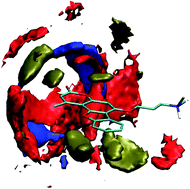Properties and behaviour of tetracyclic allopsoralen derivatives inside a DPPClipid bilayer model
Abstract
Allopsoralens are angular

* Corresponding authors
a
iMed.UL, Faculty of Pharmacy, University of Lisbon, Av. Prof. Gama Pinto, 1649-003 Lisboa, Portugal
E-mail:
dsantos@ff.ul.pt
Fax: +351 217946470
Tel: +351 217946477
b Physical Organic Chemistry and Bioprocesses Group, Department of Organic Chemistry, Facultad de Química, UdelaR, CC1157, Avda. Gral Flores 2124, Montevideo 11800, Uruguay
c School of Chemistry, National University of Ireland, University Road, Galway, Ireland
Allopsoralens are angular

 Please wait while we load your content...
Something went wrong. Try again?
Please wait while we load your content...
Something went wrong. Try again?
D. J. V. A. dos Santos, P. Saenz-Méndez, L. A. Eriksson and R. C. Guedes, Phys. Chem. Chem. Phys., 2011, 13, 10174 DOI: 10.1039/C0CP02245D
To request permission to reproduce material from this article, please go to the Copyright Clearance Center request page.
If you are an author contributing to an RSC publication, you do not need to request permission provided correct acknowledgement is given.
If you are the author of this article, you do not need to request permission to reproduce figures and diagrams provided correct acknowledgement is given. If you want to reproduce the whole article in a third-party publication (excluding your thesis/dissertation for which permission is not required) please go to the Copyright Clearance Center request page.
Read more about how to correctly acknowledge RSC content.
 Fetching data from CrossRef.
Fetching data from CrossRef.
This may take some time to load.
Loading related content
